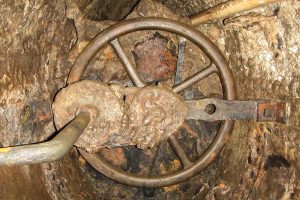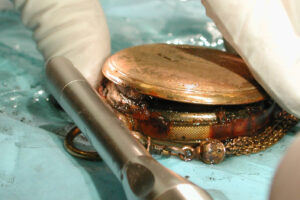(April 12, 2004 – CHARLESTON, SC) George Dixon, the H. L. Hunley’s commander, was a young and athletic man with sandy blond hair. Forensic analysis places Dixon in his mid-twenties. However, his responsibility on the Hunley was what would have been expected of an experienced veteran.
As commander, Dixon navigated the submarine, using only a compass bearing and the limited visibility provided by the view ports in the forward conning tower. Dixon controlled the movement of the rudder and the dive planes, which dictated the inclination and level of submersion of the submarine. Ultimately, Lt. Dixon was the crewmember who triggered the Hunley’s explosive device that would send the USS Housatonic to the bottom of the Atlantic ocean, a maritime first that changed the landscape of naval warfare world-wide.
During excavation of the interior of the Hunley, Dixon’s remains were located beneath the forward conning tower, the location where the vessel’s commander would have been stationed.
Doug Owsley, forensic expert with the Smithsonian Institution, found in his research that Dixon was North American born, but was not from a Southern state. “Dixon’s alignment with the Confederate Army was not based on geographic lines. He was not Southern born and is most likely from the Midwest, but has been away from home a very long time.” Standing 5 feet 9 inches tall, Dixon was a man of at least some wealth as indicated by the gold fillings found in his teeth, his diamond studded jewelry and an ornate gold watch he carried in his pocket.
Thus far, Dixon’s history can be traced to 1860 when he was a steamboat engineer traveling the Mississippi River between St. Louis and Cincinnati. When the Civil War began, Dixon was in Mobile, Alabama. For the first few years of the war, he became a part of the Mobile community and even joined the local Masonic lodge. Dixon joined the Mobile Grays, a local police force, and in October of 1861 he enlisted in the Confederate Army and was assigned to the 21st Alabama infantry.
In 1862, Dixon’s service in the Confederate Army led him to a battle in Shiloh, Tennessee. During that battle, an event occurred that would turn into one of the greatest oral legends in the history of the war.
The legend told the story of a gold coin Dixon was given as a good luck charm by a young girl when he left Mobile to go to war. During the Battle of Shiloh, Dixon was shot. According to legend, the bullet struck the gold coin in Dixon’s trousers and saved his life, leaving a deep impression on the coin’s surface.
In 2001, during the excavation of the Hunley, a $20 dollar gold piece minted in 1860 was discovered next to the remains of Lt. Dixon. It was deeply indented from the impact of a bullet and inscribed with the following words:
Shiloh
April 6, 1862
My life Preserver
G. E. D.
Maria Jacobsen, Senior Archaeologist on the Hunley project, said “We found a healed gun shot wound in Dixon’s left upper thigh, with minute lead fragments embedded in the bone.”
After his injury at Shiloh, Dixon returned to Mobile to recover. It was most likely during this time that Dixon met William Alexander, a fellow Mason and one of the builders of the Hunley. The Hunley was at least partially built at Park and Lyons machine shop, where Alexander was employed. The ironwork on the vessel was probably completed there. The Hunley had moderate success during test runs in Mobile Bay, some of which Dixon may have manned.
With the strategically valuable Fort Sumter just off shore, Charleston, the largest port in the South, quickly became the focal point of a Union blockade. As the war progressed, the blockade on Charleston Harbor became more fortified, allowing less and less runners through.
In 1863, news from Mobile of the successful trial runs of the Hunley made its way to Charleston. With the hopes this new experimental weapon might help break the Union blockade, the Hunley was sent by train to Charleston and arrived on an early August morning in 1863.
Initially, the Hunley was unsuccessful. During trial runs in Charleston in August and October 1863, 13 men lost their lives on the Hunley, one such trial even claimed the life of Horace Hunley, the submarine’s namesake.
Confident in the potential of the submarine as a combat vessel when navigated correctly, Dixon convinced General Beauregard to give the Hunley another chance with him at the helm. Dixon raised a volunteer crew, and began a series of test missions to prepare for his attack. Having confidence in his crew, Dixon waited for the sea to cooperate before he set out to attack the Housatonic.
In January 1864, Dixon expressed his frustration in a letter to a friend in Mobile. “But there is one thing very evident,” he wrote, “and that is to catch the Atlantic Ocean smooth during the winter months is considerable of an undertaking and one that I never wish to undertake again.”
Dixon would soon have such a rare moment. On February 17, 1864 he seized the opportunity the sea provided. That night, the vessel he had so much faith in became the first successful combat submarine in world history.
Lt. Dixon was well known in the Confederate Army. He was the only Hunley crewmember who left no question behind about his identity and some of the circumstances of his life. Yet his birthplace has remained unknown.
Linda Abrams, a forensic genealogist, believes that one day she will know more about the mysterious Dixon. “I will find him. I have no doubt about that. We may not know where he was from, but a letter I discovered just weeks before he is scheduled to be buried has left us no doubt about his personality. He was both a sentimental and courageous man,” Abrams said.
In that letter, Dixon wrote that his crew of submarine pioneers were, “The best I think I ever seen.”
The following is a transcription of the letter Dixon wrote 17 days before he lost his life at sea on the Hunley:
Mr. Henry Willey
Mobile, Ala.
Dear Friend Henry,
I wrote you about one month ago, and as yet have not received an answer and thinking that probably you had not received my letter I will try you with another. And as I would like to know you are getting along in the world. And whether this new conscription law is going to affect you or not and if it is can I do any thing for you if so why, let me know. I suppose that you think strange that I have not done any thing here yet, but if I could tell you all of the circumstances that have occurred since I came here you would not think strange of my not having done any execution as yet.
But it would take considerable paper and time to relate them to you at present so I will postpone relating them until I see you. But there is one thing very evident and that is to catch the Atlantic Ocean smooth during the winter months is considerable of an undertaking and one that I never wish to undertake again. Especially when all parties interested are sitting at home and wondering and criticizing all of my actions and saying why don’t he do something. if I have not done any thing “God Knows” it is not because I have not worked hard enough to do some thing.
And I shall keep trying until I do some thing. I have been out-side several times but for various reasons I have not yet met with success. I am out-side every night in a small boat so that there is not a possible for any good night to pass with out my being able to take advantage of it. I have my boat lying between Sullivan’s and Long Islands and think that
when the night does come that I will surprise the Yankees completely. The Fleet offshore have drawings of the sub-marine and of course they have taken all precautions that it is possible for Yankee ingenuity to invent, but I hope to Flank them yet.
I am living on a soldier’s rations here and have been for the last six weeks and find that is



